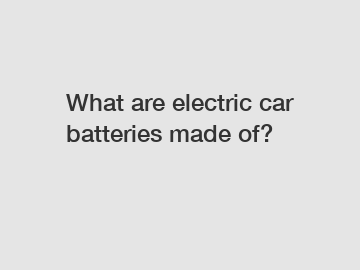What are electric car batteries made of?
Electric cars are gaining popularity as more people seek environmentally-friendly transportation options. One crucial component of an electric vehicle is its battery, which powers the electric motor and allows the car to operate. But what are electric car batteries made of? In this article, we will explore the materials that make up these essential components.
Composition of Electric Car Batteries.
Lithium-Ion Batteries.

The most common type of battery used in electric cars is the lithium-ion battery. These batteries are lightweight, compact, and can store a significant amount of energy. A typical lithium-ion battery consists of three main components: a cathode, anode, and electrolyte.
Cathode.
The cathode of a lithium-ion battery is typically made of lithium cobalt oxide, lithium iron phosphate, or lithium nickel manganese cobalt oxide. These materials are chosen for their ability to store and release lithium ions efficiently, allowing the battery to hold a charge for extended periods.
Anode.
The anode of a lithium-ion battery is usually made of graphite, which serves as a host for lithium ions during charging. Graphite is chosen for its stability and ability to withstand repeated charging and discharging cycles without degrading.
Electrolyte.
The electrolyte in a lithium-ion battery is a liquid or gel substance that allows lithium ions to move freely between the cathode and anode during charging and discharging. The electrolyte is typically made of lithium salts dissolved in a solvent, which facilitates the movement of ions.
Other Components.
In addition to the cathode, anode, and electrolyte, lithium-ion batteries also contain other components such as a separator, which prevents the cathode and anode from coming into direct contact and causing a short circuit, and a casing, which houses the battery cells and protects them from external damage.
Recycling Electric Car Batteries.
As electric vehicles become more widespread, the question of what to do with old or worn-out batteries becomes increasingly important. Recycling electric car batteries is crucial to minimize environmental impact and recover valuable materials such as lithium, cobalt, and nickel. The process of recycling electric car batteries involves disassembling the battery pack, crushing and shredding the components, and extracting valuable metals through a combination of mechanical and chemical processes.
Future Developments.
Researchers and manufacturers are continuously working to improve the performance, safety, and sustainability of electric car batteries. One promising development is the use of solid-state lithium batteries, which replace the liquid or gel electrolyte with a solid material. Solid-state batteries offer higher energy density, longer lifespan, and improved safety compared to traditional lithium-ion batteries. Other efforts focus on reducing the use of critical materials such as cobalt and nickel, which can have significant environmental and ethical implications.
Conclusion.
Electric car batteries are essential components that power the growing fleet of electric vehicles on the road today. By understanding the materials that make up these batteries, including lithium-ion technology, recycling processes, and future developments, we can appreciate the ongoing advancements in electric vehicle technology. As demand for electric vehicles continues to rise, it is important to consider the materials used in their batteries and the impact of these technologies on the environment. Contact us to learn more about electric car batteries and their components.
For more information, please visit agm battery disadvantages, what is an enhanced flooded battery, start stop battery price.

